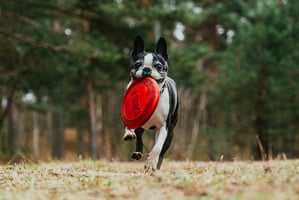Licking is a common problem for dog owners. It can be annoying and even potentially dangerous. In...
How to Get a Dog to Stop Jumping Up
Training a dog to stop jumping up can be a difficult task, but with consistency, patience, and positive reinforcement, it is possible to help your dog learn to control their behaviour and greet people without jumping up. This article will provide tips on how to get a dog to stop jumping up, including important considerations about why your dog is jumping up, the use of rewards-based training, and the importance of consistency and patience.
Understand Why Your Dog is Jumping Up
Before you can begin to train your dog to stop jumping up, it is important to understand why your dog is jumping up in the first place. Dogs may jump up for a variety of reasons, such as excitement, attention seeking, or dominance. Knowing why your dog is jumping up will help you to address the behaviour more effectively.
If your dog is jumping up out of excitement, then they may be trying to get close to you and show their affection. You can help your dog learn to express their excitement in a more appropriate way by teaching them a command such as “sit” and rewarding them with a treat and praise when they do so.
If your dog is jumping up in order to get your attention, then you should avoid giving them attention when they jump up. Instead, you should reward them for calm behaviour, such as sitting or lying down, with a treat and praise. This will help your dog to understand that calm behaviour is more likely to get them the attention they crave.
If your dog is jumping up in a dominance display, then you should avoid responding to the behaviour with physical punishment. Instead, you should use rewards-based training to teach your dog that they will not be rewarded for jumping up and that calm behaviour will get them the attention they desire.
Use Rewards-Based Training
Once you have identified the reason why your dog is jumping up, you can begin to use rewards-based training to help them to learn to control their behaviour. Rewards-based training involves rewarding your dog for desired behaviour with treats, praise, and affection, and avoiding giving them attention when they behave in an undesirable way.
When your dog jumps up, turn away from them and ignore the behaviour. If your dog continues to jump up, you can use a verbal command such as “no” or “down” to let them know that the behaviour is not acceptable. When your dog stops jumping up, reward them with a treat and praise. This will help your dog to understand that jumping up is not rewarded, and that calm behaviour will get them the attention they desire.
It is also important to reward your dog when they greet people in an appropriate manner. When someone approaches your dog, ask them to sit and reward them with a treat and praise when they do so. This will help your dog to understand that they should not jump up when greeting people.
Be Consistent and Patient
Training a dog to stop jumping up can be a difficult and time-consuming task, and it is important to be consistent and patient during the process. Your dog may take some time to learn the desired behaviour, and it is important to remain consistent and avoid giving up if your dog does not seem to be making progress.
It is also important to remember that rewards-based training should be used consistently. If you only reward your dog for calm behaviour sometimes, then they may become confused and not understand what behaviour is expected of them.
Finally, it is important to remember that training a dog to stop jumping up is a long-term process. You should not expect your dog to learn the desired behaviour overnight, and you should remain patient and consistent throughout the process.
Conclusion
Training a dog to stop jumping up can be a difficult task, but with consistency, patience, and rewards-based training, it is possible to help your dog learn to control their behaviour and greet people without jumping up. It is important to understand why your dog is jumping up, use rewards-based training to encourage the desired behaviour, and be consistent and patient during the process.



